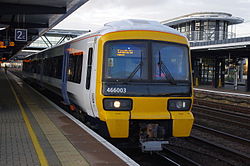Networker (train)
passenger train family built for British Rail From Wikipedia, the free encyclopedia
The Networker is a family of trains which operate on the UK railway system. They were built in the late 1980s and early 1990s by BREL and Metropolitan Cammell which later became ABB. The trains were built for the Network SouthEast sector of British Rail. They are all multiple unit trains.
| Networker | |
|---|---|
 | |
| In service | 1989–present |
| Manufacturer |
|
| Number built | 344 sets |
| Number scrapped | 40 sets |
| Operators |
|
| Specifications | |
| Maximum speed | 75–100 mph (121–161 km/h) |
| Track gauge | 1,435 mm (4 ft 8 1⁄2 in) standard gauge |
Versions





Diesel multiple units
Class 165
The Class 165 is a 2- and 3-car diesel multiple unit (DMU),
Thirty-nine units were for the Chiltern subdivision of Network SouthEast. They were made from 1990 to 1991.
Thirty-seven were made for the Thames subdivision in 1992.
After privatisation, the Class 165/0 units have been operated by Chiltern Railways, and the Class 165/1 units have been operated by Thames Trains, First Great Western Link, First Great Western and Great Western Railway .[1]
Class 166
The Class 166 is a faster, air-conditioned version of the Class 165. Twenty-one 3-car units were made for the Thames and North Downs subdivisions of Network SouthEast from 1992 to 1993.[1]
Electric multiple units
Classes 316 and 457
These designations applied to a single four-car electric multiple unit (EMU), converted from former Class 210 carriages, that was used as a research prototype. The unit was numbered as a Class 457 unit for trials with power from 750 V direct current (DC) third rail on Southern Region lines, then as a Class 316 unit for trials with power from 25 kV alternating current (AC) overhead line equipment on lines north of the River Thames, for which one of its intermediate carriages was replaced with a Class 313 pantograph trailer.
Class 365
The Class 365 was a dual-voltage EMU. Forty-one 4-car units were made from 1994 to 1995,[2]
Class 465
The Class 465 is a four-car EMU, it is powered from 750 V DC third rail. They were made by British Rail Engineering Limited (465/0), ABB (465/1), and Metro Cammell (465/2) in slightly different versions. They were used by Network SouthEast, after privatisation they went to Connex South Eastern, then to South Eastern Trains then to Southeastern and are now operated by SE Trains.
Class 466
The Class 466 is a two-car EMU. It is powered from 750 V DC third rail. Three units were made from 1993 to 1994 by Metro Cammell (who built the 465/2s).
Unbuilt
Class 171
Class 171 was a long distance DMU that was proposed but was never made. There was seventy 'Turbo Express' trains planned for long distance, unelectrified routes. However, Regional Railways had ordered too many Class 158 trains, and Network South East agreed to take on the 158 trains, So the Class 171 trains were not made.[1]
Class 331 and 332
Class 331 and 332 were two middle distance EMU types that were proposed and never made. 300 Class 331 'Networker LT&S' carriages were planned for the 'Total Route Modernisation' on the London, Tilbury and Southend line. But instead, 74 Bombardier built Class 357 Electrostar trains entered service from 2000[1] so the Class 331 trains were not made.
Twenty Class 332 'Networker Heathrow' trains were planned to be made for Heathrow Express services. Instead, 14 CAF made Class 332 trains entered service in 1998 on Heathrow Express services[1] so the Class 332 trains were not made.
Class 341 and 342
Class 341 and 342 were middle distance EMU types that were proposed but never made. Class 341 'Networker Crossrail' was meant to be the rolling stock for Crossrail but Crossrail was cancelled in 1990, so the Classes 341 and 342 trains were not made.
Class 371, 381 and 471
Class 371, 381 and 471 were three long distance EMU types that were proposed but never made. Classes 371 and 381 were proposed as the "Universal Networker", a dual voltage train for lots of different services including Kent Coast, Great Northern, Thameslink and LTS routes.
Class 471 was the proposed "main line Networker", It was going to be used for long-distance services from London to Kent and Sussex.[1]
The Class 365 train was ordered in 1993,. After the privatisation of British Rail in 1994, no Class 371, 381 and 471 trains were not made.[1]
Comparison
| Class | Image | Current operator | Introduced | Qty. | Cars | Car length |
|---|---|---|---|---|---|---|
| Diesel multiple units | ||||||
| 165 |  |
Chiltern Railways | 1990–1992 | 39 | 2 or 3 | 22 m (72 ft 2 in) |
 |
Great Western Railway | 1992 | 36 | 2 or 3 | 22 m (72 ft 2 in) | |
| 166 |  |
1992–1993 | 21 | 3 | 22 m (72 ft 2 in) | |
| Dual-voltage | ||||||
| 316 and 457 |  |
(Scrapped, preserved or inserted into Class 455 units) | 1989–1990 | 1 | 4 | |
| 365 |  |
(Scrapped)[3] | 1994–1995 | 41 | 4 | 20 m (65 ft 7 in) |
| DC electric only | ||||||
| 465 |  |
Southeastern | 1991–1994 | 147 | 4 | 20 m (65 ft 7 in) |
| 466 |  |
1993–1994 | 43 | 2 | 20 m (65 ft 7 in) | |
References
Wikiwand - on
Seamless Wikipedia browsing. On steroids.
